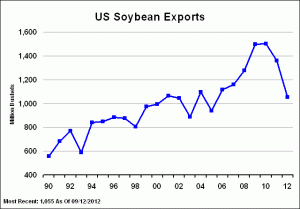(i) What Went Wrong
(ii) The Road Ahead
For my first trade I chose a long buy March soybean contract (S3H) hoping that there would be the shortage of supply in long run because of a severe drought which has destroyed virtually well over 50 percent of USA’s harvest. There was estimation by United States Department of Agriculture (USDA) on September 12, 2012 that the soybeans harvest would be less than forecasted, so USDA made a cut in its forecast on Wednesday last week.
The first reason for my choice was USDA’s forecast; I was hoping to make money in long run, so if I buy at a current price, after I can sell it at a higher price. Furthermore, I looked at the USA’s this year’s soybeans production and export, from that it’s clear that there global supply will remain extremely tight after the worst drought in USA. In addition to USDA’s forecast, China, a number one importer of soybeans, buys about 60% of globally traded soybeans, so there was expectation that it would incur shortage of supply in fall that would lead to a price increase.


see at “http://www.cmegroup.com/trading/agricultural/grain-and-oilseed/soybean_learn_more_reports.html”
However, my expectation did not prove itself because everything went different from anticipated. Even though analysts believe that global supply of soybeans will be lower due to a severe drought, the reality was better than expected that caused a price decrease at the Chicago Board of Trade. The extreme drought has damaged the US soybean crop; however the later planted soybeans and double crop soy took advantage from a late rain. “We went up on soybean yields because of late rains and actual harvest results. We’re hearing better yields across the crop belt. The late rains really did help,” said Don Roose, president of US Commodities, Des Moines, Iowa. Therefore, this week’s events were different from USDA’s September survey.
Furthermore, China, the world’s number importer, cut its purchases because China has switched its export to import that means China will carry its selling soybean reserves into 2013 to ease tight suppliers from USA. Thus, China may reduce its amount of imports.
Briefly, all these events leaded to the loss in my account.
(i) The Road Ahead
Although taking a long buy position was not good idea, I will hold this position next week.
Last week China’s slowing imports was one of reasons for a price decrease, China buys 60 percent of globally traded soybeans in 2012-2013, so these reserves may reduce its import, but it could reduce by a small amount because it is estimated that Beijing’s stockpile is sufficient no more than approximately two months of consumption. Thus, I am still hoping that there will be jump, so I can offset my position. Also, worsening weather outside of America could cause prices of grains and oil seeds to be higher. According to USDA, South America will not have sufficient soybean supplies to sell to China until March 2013 at the earliest. Moreover, although a late rain has improved soybean harvest, the damage of soybean production was significant,so still hoping that overall supply will be less.
In addition to soybean, I am going to trade a short sell wheat contract because I am anticipating an increase in wheat prices. It is expected that as of October Russia will constrain its overseas shipment as it was in 2010. The government considers regulating its domestic price for wheat by imposing restrictions on its export. If it happens, the price will drive up significantly in future markets. (see for more details a previous post on September 21 titled “The Road Ahead”)
References:
http://www.brecorder.com/markets/commodities/america/80552-us-soybean-yields-improve-after-late-summer-rains-.html
http://in.reuters.com/article/2012/09/17/markets-grains-idINL3E8KH0L120120917
http://www.bloomberg.com/news/2012-09-21/crop-prices-probably-peaked-after-drought-cuts-u-s-output-2-.html
http://af.reuters.com/article/commoditiesNews/idAFL4E8KK0IO20120920
http://www.minnesotafarmguide.com/news/markets/soybean-harvest-begins-across-the-united-states/article_eb4ba87a-03e6-11e2-935b-0019bb2963f4.html


